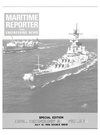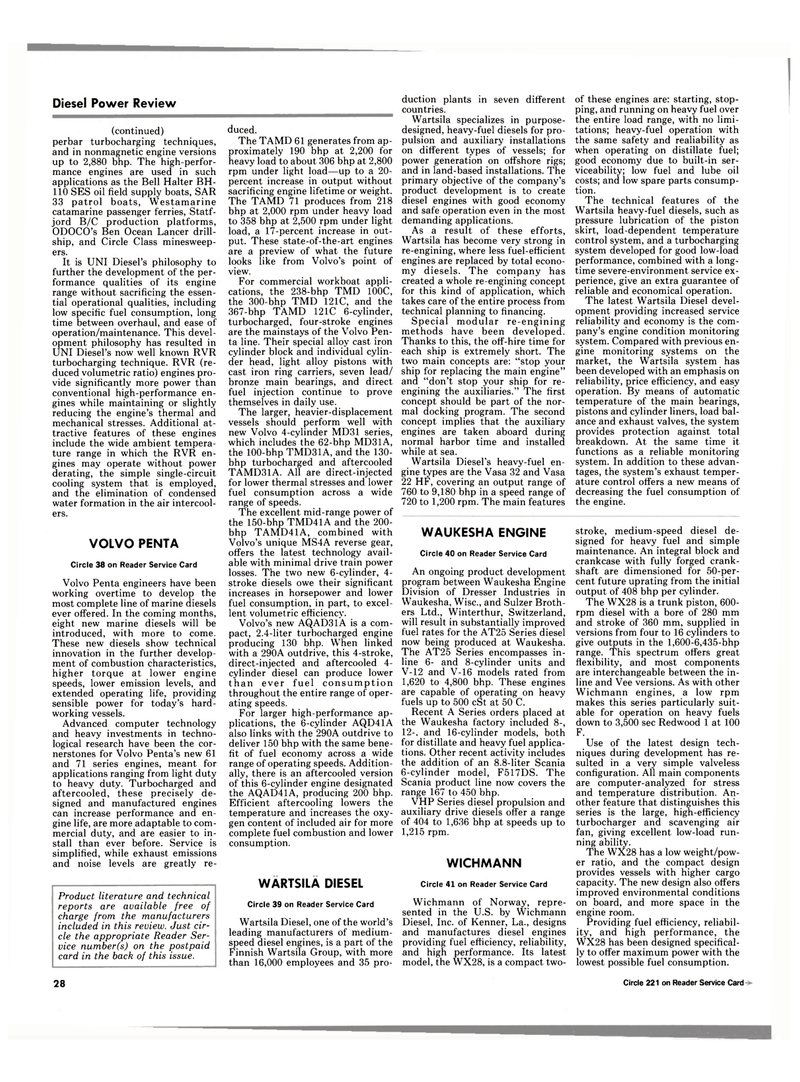
Page 28: of Maritime Reporter Magazine (July 15, 1986)
Read this page in Pdf, Flash or Html5 edition of July 15, 1986 Maritime Reporter Magazine
Diesel Power Review (continued) perbar turbocharging techniques, and in nonmagnetic engine versions up to 2,880 bhp. The high-perfor- mance engines are used in such applications as the Bell Halter BH- 110 SES oil field supply boats, SAR 33 patrol boats, Westamarine catamarine passenger ferries, Statf- jord B/C production platforms,
ODOCO's Ben Ocean Lancer drill- ship, and Circle Class minesweep- ers.
It is UNI Diesel's philosophy to further the development of the per- formance qualities of its engine range without sacrificing the essen- tial operational qualities, including low specific fuel consumption, long time between overhaul, and ease of operation/maintenance. This devel- opment philosophy has resulted in
UNI Diesel's now well known RVR turbocharging technique. RVR (re- duced volumetric ratio) engines pro- vide significantly more power than conventional high-performance en- gines while maintaining or slightly reducing the engine's thermal and mechanical stresses. Additional at- tractive features of these engines include the wide ambient tempera- ture range in which the RVR en- gines may operate without power derating, the simple single-circuit cooling system that is employed, and the elimination of condensed water formation in the air intercool- ers.
VOLVO PENTA
Circle 38 on Reader Service Card
Volvo Penta engineers have been working overtime to develop the most complete line of marine diesels ever offered. In the coming months, eight new marine diesels will be introduced, with more to come.
These new diesels show technical innovation in the further develop- ment of combustion characteristics, higher torque at lower engine speeds, lower emission levels, and extended operating life, providing sensible power for today's hard- working vessels.
Advanced computer technology and heavy investments in techno- logical research have been the cor- nerstones for Volvo Penta's new 61 and 71 series engines, meant for applications ranging from light duty to heavy duty. Turbocharged and aftercooled, these precisely de- signed and manufactured engines can increase performance and en- gine life, are more adaptable to com- mercial duty, and are easier to in- stall than ever before. Service is simplified, while exhaust emissions and noise levels are greatly re-
Product literature and technical reports are available free of charge from the manufacturers included in this review. Just cir- cle the appropriate Reader Ser- vice number(s) on the postpaid card in the back of this issue. duced.
The TAMD 61 generates from ap- proximately 190 bhp at 2,200 for heavy load to about 306 bhp at 2,800 rpm under light load—up to a 20- percent increase in output without sacrificing engine lifetime or weight.
The TAMD 71 produces from 218 bhp at 2,000 rpm under heavy load to 358 bhp at 2,500 rpm under light load, a 17-percent increase in out- put. These state-of-the-art engines are a preview of what the future looks like from Volvo's point of view.
For commercial workboat appli- cations, the 238-bhp TMD 100C, the 300-bhp TMD 121C, and the 367-bhp TAMD 121C 6-cylinder, turbocharged, four-stroke engines are the mainstays of the Volvo Pen- ta line. Their special alloy cast iron cylinder block and individual cylin- der head, light alloy pistons with cast iron ring carriers, seven lead/ bronze main bearings, and direct fuel injection continue to prove themselves in daily use.
The larger, heavier-displacement vessels should perform well with new Volvo 4-cylinder MD31 series, which includes the 62-bhp MD31A, the 100-bhp TMD31A, and the 130- bhp turbocharged and aftercooled
TAMD31A. All are direct-injected for lower thermal stresses and lower fuel consumption across a wide range of speeds.
The excellent mid-range power of the 150-bhp TMD41A and the 200- bhp TAMD41A, combined with
Volvo's unique MS4A reverse gear, offers the latest technology avail- able with minimal drive train power losses. The two new 6-cylinder, 4- stroke diesels owe their significant increases in horsepower and lower fuel consumption, in part, to excel- lent volumetric efficiency.
Volvo's new AQAD31A is a com- pact, 2.4-liter turbocharged engine producing 130 bhp. When linked with a 290A outdrive, this 4-stroke, direct-injected and aftercooled 4- cylinder diesel can produce lower than ever fuel consumption throughout the entire range of oper- ating speeds.
For larger high-performance ap- plications, the 6-cylinder AQD41A also links with the 290A outdrive to deliver 150 bhp with the same bene- fit of fuel economy across a wide range of operating speeds. Addition- ally, there is an aftercooled version of this 6-cylinder engine designated the AQAD41A, producing 200 bhp.
Efficient aftercooling lowers the temperature and increases the oxy- gen content of included air for more complete fuel combustion and lower consumption.
WARTSILA DIESEL
Circle 39 on Reader Service Card
Wartsila Diesel, one of the world's leading manufacturers of medium- speed diesel engines, is a part of the
Finnish Wartsila Group, with more than 16,000 employees and 35 pro- duction plants in seven different countries.
Wartsila specializes in purpose- designed, heavy-fuel diesels for pro- pulsion and auxiliary installations on different types of vessels; for power generation on offshore rigs; and in land-based installations. The primary objective of the company's product development is to create diesel engines with good economy and safe operation even in the most demanding applications.
As a result of these efforts,
Wartsila has become very strong in re-engining, where less fuel-efficient engines are replaced by total econo- my diesels. The company has created a whole re-engining concept for this kind of application, which takes care of the entire process from technical planning to financing.
Special modular re-engining methods have been developed.
Thanks to this, the off-hire time for each ship is extremely short. The two main concepts are: "stop your ship for replacing the main engine" and "don't stop your ship for re- engining the auxiliaries." The first concept should be part of the nor- mal docking program. The second concept implies that the auxiliary engines are taken aboard during normal harbor time and installed while at sea.
Wartsila Diesel's heavy-fuel en- gine types are the Vasa 32 and Vasa 22 HF, covering an output range of 760 to 9,180 bhp in a speed range of 720 to 1,200 rpm. The main features of these engines are: starting, stop- ping, and running on heavy fuel over the entire load range, with no limi- tations; heavy-fuel operation with the same safety and realiability as when operating on distillate fuel; good economy due to built-in ser- viceability; low fuel and lube oil costs; and low spare parts consump- tion.
The technical features of the
Wartsila heavy-fuel diesels, such as pressure lubrication of the piston skirt, load-dependent temperature control system, and a turbocharging system developed for good low-load performance, combined with a long- time severe-environment service ex- perience, give an extra guarantee of reliable and economical operation.
The latest Wartsila Diesel devel- opment providing increased service reliability and economy is the com- pany's engine condition monitoring system. Compared with previous en- gine monitoring systems on the market, the Wartsila system has been developed with an emphasis on reliability, price efficiency, and easy operation. By means of automatic temperature of the main bearings, pistons and cylinder liners, load bal- ance and exhaust valves, the system provides protection against total breakdown. At the same time it functions as a reliable monitoring system. In addition to these advan- tages, the system's exhaust temper- ature control offers a new means of decreasing the fuel consumption of the engine.
WAUKESHA ENGINE
Circle 40 on Reader Service Card
An ongoing product development program between Waukesha Engine
Division of Dresser Industries in
Waukesha, Wise., and Sulzer Broth- ers Ltd., Winterthur, Switzerland, will result in substantially improved fuel rates for the AT25 Series diesel now being produced at Waukesha.
The AT25 Series encompasses in- line 6- and 8-cylinder units and
V-12 and V-16 models rated from 1,620 to 4,800 bhp. These engines are capable of operating on heavy fuels up to 500 cSt at 50 C.
Recent A Series orders placed at the Waukesha factory included 8-, 12-. and 16-cylinder models, both for distillate and heavy fuel applica- tions. Other recent activity includes the addition of an 8.8-liter Scania 6-cylinder model, F517DS. The
Scania product line now covers the range 167 to 450 bhp.
VHP Series diesel propulsion and auxiliary drive diesels offer a range of 404 to 1,636 bhp at speeds up to 1,215 rpm.
WICHMANN
Circle 41 on Reader Service Card
Wichmann of Norway, repre- sented in the U.S. by Wichmann
Diesel, Inc. of Kenner, La., designs and manufactures diesel engines providing fuel efficiency, reliability, and high performance. Its latest model, the WX28, is a compact two- stroke, medium-speed diesel de- signed for heavy fuel and simple maintenance. An integral block and crankcase with fully forged crank- shaft are dimensioned for 50-per- cent future uprating from the initial output of 408 bhp per cylinder.
The WX28 is a trunk piston, 600- rpm diesel with a bore of 280 mm and stroke of 360 mm, supplied in versions from four to 16 cylinders to give outputs in the 1,600-6,435-bhp range. This spectrum offers great flexibility, and most components are interchangeable between the in- line and Vee versions. As with other
Wichmann engines, a low rpm makes this series particularly suit- able for operation on heavy fuels down to 3,500 sec Redwood 1 at 100
F.
Use of the latest design tech- niques during development has re- sulted in a very simple valveless configuration. All main components are computer-analyzed for stress and temperature distribution. An- other feature that distinguishes this series is the large, high-efficiency turbocharger and scavenging air fan, giving excellent low-load run- ning ability.
The WX28 has a low weight/pow- er ratio, and the compact design provides vessels with higher cargo capacity. The new design also offers improved environmental conditions on board, and more space in the engine room.
Providing fuel efficiency, reliabil- ity, and high performance, the
WX28 has been designed specifical- ly to offer maximum power with the lowest possible fuel consumption. 28 Circle 221 on Reader Service Card

 27
27

 29
29
